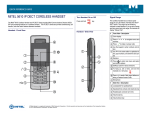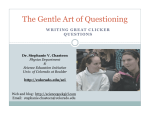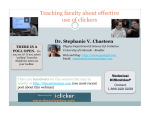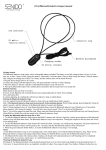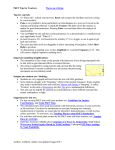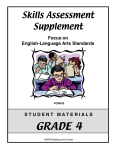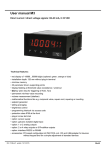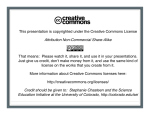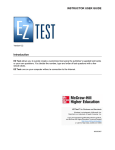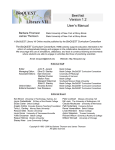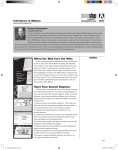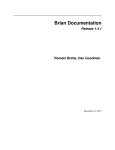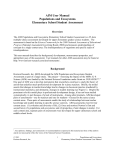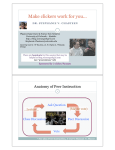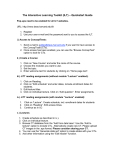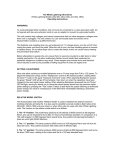Download Five Easy Steps to Peer Instruction
Transcript
Creating Effective Learning Environments: Five Easy Steps to Peer Instruction Boston University Slideshow Title Goes Here Bennett Goldberg Physics STEM Education Initiatives MSU College Teaching Certificate Thursday, May 14, 2015 Props to: Stephanie Chasteen, CU Boulder and SEI Eric Mazur, Harvard University Derek Bruff, Vanderbilt Kathryn Spilios, Boston University Andrew Duffy, Boston University Jenny Knight, CU Boulder Rique Campa, MSU Peter Newbury, UCSD Boston University Slideshow Title Goes Here 3 Two way conversations with students are vital... 4 ...because students can misunderstand what we say “Pearls Before Swine” by Stephan Pastis, 2002. “Clickers” are really just a focal point We aim to help instructors: • Use student-centered, interactive teaching techniques • By the use of a tool (clickers) which makes a transition to that pedagogy easier Our talks are “how people learn” talks in disguise. J Bransford, Brown, Cocking (1999), How People Learn 5 Using the Clicker The clickers should be easy to use. When I ask a multiplechoice question and start the timer, just choose an answer and hit that button on your clicker. Clicker responses (right or wrong) count toward your participation grade. 6 Why we re using clickers The clickers are designed to get you involved in the class, by encouraging discussion between you and your classmates and between you and the course staff. 7 Icons for peer instruction This icon means this is an individual activity - start by answering the questions on your own. When you have done this individually, compare notes with the members of your group. 8 Have you used response systems (clickers) in your teaching? Take a clicker If the green light flashes, your vote has been counted 1. 2. 3. 4. 5. Not at all, and I haven’t seen them used Not at all, but I’ve observed their use somewhat I’ve used them a little I’ve used them a lot I could be (should be?) giving this workshop 9 How familiar are you with “Peer Instruction” 1. 2. 3. 4. 5. Fairly familiar, and I like it Fairly familiar, but I’m not sure that I like it I’ve heard of it but only have a vague idea what it is Not familiar at all Not sure 10 Example question: Biology A small acorn over time can grow into a huge oak tree. The tree can weigh many tons. Where does most of the mass come from as the tree grows? 1. 2. 3. 4. Minerals in the soil Organic matter in the soil Gases in the air Sunlight A Private Universe; Annenberg Media 11 Example question: Biology A small acorn over time can grow into a huge oak tree. The tree can weigh many tons. Where does most of the mass come from as the tree grows? 1. 2. 3. 4. Minerals in the soil Organic matter in the soil Gases in the air Sunlight A Private Universe; Annenberg Media 12 Minimum length When you add two vectors, with lengths of 4.0 m and 7.0 m, what is the minimum possible length of the resultant vector? 1. -3.0 m 2. 0m 3. +3.0 m 4. +4.0 m 13 Minimum length When you add two vectors, with lengths of 4.0 m and 7.0 m, what is the minimum possible length of the resultant vector? 1. -3.0 m 2. 0m 3. +3.0 m 4. +4.0 m 14 Minimum length When you add two vectors, with lengths of 4.0 m and 7.0 m, what is the minimum possible length of the resultant vector? 1. -3.0 m 2. 0m 3. +3.0 m 4. +4.0 m Just subtract the two. Length is a scalar, and can’t be negative. 15 Clicker question about questions The toughest thing about asking questions in class is… 1. Writing good questions 2. Getting students to really think about them 3. Getting students to answer the questions / Nobody responds 4. The same students always respond / Not everybody responds 5. It takes too long / I have a lot of content to cover 16 Clicker question about questions The toughest thing about asking questions in class is… 1. Writing good questions 2. Getting students to really think about them 3. Getting students to answer the questions / Nobody responds 4. The same students always respond / Not everybody responds 5. It takes too long / I have a lot of content to cover 17 Presentation and Observation of Peer Instruction 18 Part B: Elements of Peer Instruction 19 Anatomy of Peer Instruction Ask Question (Maybe vote) …Lecture… Class Discussion Peer Discussion Vote * See also: Peer Instruction, A User’s Manual. E. Mazur. 20 Doing Physics: Active-Learning Active-Learning Class Pre-Class Small-Group Preparation Discussion Homework/Quiz Practice 21 The following is a list of changes in a tissue undergoing cellular respiration. Which of them would have NO EFFECT on hemoglobin’s affinity for oxygen? A. Build up of CO2 B. Change in pH C. Drop in PO2 from alveoli to ;ssues D. All of the above would effect hemoglobin’s affinity for O2 22 You have discovered a molecule that blocks K+ channels in sensory neurons in the skin. You’d like to market this drug as a pain management drug. Which of the following would be the most accurate description of the drug’s effect? A. The pa;ent will feel no pain, but will s;ll feel touch and pressure B. The pa;ent will be totally numb C. The pa;ent may feel a short burst of pain and sensa;on, followed by numbness 23 You are studying a neuron that you isolated from an animals. When you examine the synap;c vesicles you discover that they contain an unknown neurotransmiJer. The neurotransmiJer seems to open K+ channels on other neurons. You hypothesize that your neuron has A. Inhibitory effects B. Excitatory effects C. It is impossible to know without more info 24 Analyze Step 1: Question Cycle: Before/During/After 25 BEFORE Setting up instruction Motivate Discover Predict outcome Provoke thinking Assess prior knowledge AFTER Assessing learning Relate to big picture Demonstrate success Review or recap Exit poll DURING Developing knowledge Check knowledge Application Analysis Evaluation Synthesis Exercise skill Elicit misconception Credit: Rosie Piller and Ian Beatty. When to ask questions 1: Before & After After Instruction Before Instruction • Motivate students • – Why is it important to…? – What steps did you go through to solve the problem? – What might we want to…? – What kinds of things can go wrong? • – What needs to happen when you…? – Predict and show: We have seen that X happens when we do Y. What do you think will happen when…? • – What are the most important things to remember? Help them discover information – What do we have to take into account when we…? Assess prior knowledge or provoke thinking/discussion – What do you think about…? – Would you/do you…? – What do you think will happen if…? Have students recap what they have learned – Exit poll: What did we learn today? • Ask them to relate information to the big picture – How does this lead into the next topic? • Demonstrate success and limits of understanding – Ask questions that students have built an understanding of during the class. – Ask questions that go beyond what was done in class See also the Bloom’s Taxonomy handout for question stems 26 When to ask questions 2: During • Test knowledge of facts – What are the three types of…? – Can you define…? • Test comprehension of concepts – Which statements support…? – What examples can you think of? • Test applications of concepts – What would happen if…? – Which of the following are X? • Help them analyze what they are learning – Based on the symptoms, what would you say is going on? – What is the relationship between…? • Test their ability to evaluate – Here are two solutions. Which is more appropriate and why? – Which of these is more important? • Provoke them to synthesize their understanding. – How would you test…? – Propose a way to… • Elicit a misconception – Ask questions where a common student misconception will result in a particular response • Exercise a skill – How would you…? – What is the next step in this problem? See also the Bloom’s Taxonomy handout for question stems 27 Analyze Step 2: Use questions at a variety of cognitive depth Bloom’s Taxonomy of the Cognitive Domain Do the questions you use intellectually challenge your students or simply assess their factual knowledge? Higher order ---------------Lower order handout 28 Analyze Step 3: Effective multiple-choice questions have believable “distracters.” 29 1) Talking with other instructors that have taught the course in the past. 2) Talking with your students one-on-one before class, after class, during office hours. 3) Using student responses to openended questions that you include in HW and exams. 4) Asking your students to come up with answers that will be used as the choices. 5) Use researched and documented student misconceptions. D. Duncan, Univ. of Colorado 29 Part C: Let’s analyze clicker questions For each of the three clicker questions, together analyze the questions on the first page of Part C. Once you are done, start on the second set of clicker questions, revised version of the first set 30 Question-writing tips • • • • • • • • Move away from simple quizzes Use questions that prompt discussion Use questions that emphasize reasoning or process Use clear wording Use tempting distracters Use questions for a variety of instructional goals Use questions at a mixture of cognitive depth Ask challenging questions – don’t just test memorized facts See handout 31 Tips for writing clicker questions* *particularly for use with peer instruction • Don’t make them too easy. You can ask multiple choice questions at higher levels of Bloom’s! Don’t just test memorized facts. • Use questions that will prompt discussion. Interesting questions that students can’t answer on their own are more likely to spur productive discussion. • Use questions that emphasize reasoning or process over the right answer. Students need to be convinced that understanding strategies will get them a good grade. • Use clear wording so that students understand what they are being asked. • Write tempting distractors using your knowledge of student difficulties. For example, look at student answers on exams or quizzes, or first give the question as an open-ended question to generate common wrong answers. • Consider creative questions. You can survey your students, ask them how well they understand, break problems into parts, or use pictures or graphs in the answer choices. • Good sources of questions: – – – – – Questions your students ask you or that you overhear Common analogies you use as a teacher A series of connected questions to lead students through reasoning Interpret graphs, data, pictures, etc. Discussion questions where there is no one right answer See also handout 32 Part D: Create your own clicker question Then share with your group 33 Create, rate and swap • Use the Bloom’s Taxonomy worksheet to rate the Bloom’s level of your question • Swap your question with a neighbor. Do you agree on the Bloom’s level of your question? • Use the verbs on the detailed Bloom’s handout to “Bloomify up” the level of your question. 5 minutes 34 Part E: What are your top three concerns regarding using clickers and peer instruction in your teaching? Then share with your group 35 Share out • What did you learn in this process? • What worked well, what was challenging? • How might you go about writing questions in your class? But… The perfect question doesn’t solve all problems! Peer Instruction Learning Mode, part 1 When your group is involved in learning, which of the following best describes how you interact: 1. I always express my opinion and then attempt to defend it. 2. I listen to the opinion of others and then enter the conversation by supporting one or another. 3. I sit back and listen to the discussion and then make up my own mind. 4. I listen to the conversation but then wait for the instructor/professor to explain the correct answer 38 Studio Learning Mode, part 2 Consider the different learning modes used in this studio section. Rank order the following learning modes from most to least valuable in terms of your own learning: A. Discussing clicker questions, worksheets, and lab activities with my peers at the table B. Discussing clicker questions, worksheets, and lab activities with the instructors (Professor, TA's, LA's) during class. C. Hearing and thinking about the discussion and then getting the professor's description at the end. • • • • • • A, B, C B, C, A C, B, A A, C, B B, A, C C, A, B 39 Studio Learning Mode, part 2 Consider the different learning modes used in this studio section. Rank order the following learning modes from most to least valuable in terms of your own learning: A. Discussing clicker questions, worksheets, and lab activities with my peers at the table B. Discussing clicker questions, worksheets, and lab activities with the instructors (Professor, TA's, LA's) during class. C. Hearing and thinking about the discussion and then getting the professor's description at the end. 1. 2. 3. 4. 5. 6. A, B, C B, C, A C, B, A A, C, B B, A, C C, A, B 40 Slides about “Questioning” for Clicker Workshops 41 Dr. Stephanie V. Chasteen Physics Department & Science Ed. Initiative University of Colorado – Boulder http://STEMclickers.colorado.edu [email protected] Co-presenters have included Steven Pollock, Jenny Knight, Trish Loeblein, and Kathy Perkins. This presentation is copyrighted under the Creative Commons License Attribution Non-Commercial Share-Alike That means: Please watch it, share it, and use it in your presentations. Just give us credit, don’t make money from it, and use the same kind of license on the works that you create from it. More information about Creative Commons licenses here: http://creativecommons.org/licenses/ Credit should be given to: Stephanie Chasteen and the Science Education Initiative at the University of Colorado, http://colorado.edu/sei 42 Action Plan 43 What will you do to implement ideas you heard about in this workshop? OR what key ideas will you share with a colleague? (See Clicker Tips sheet for summary!) 1. 2. 3. 43 Whiteboard 44












































